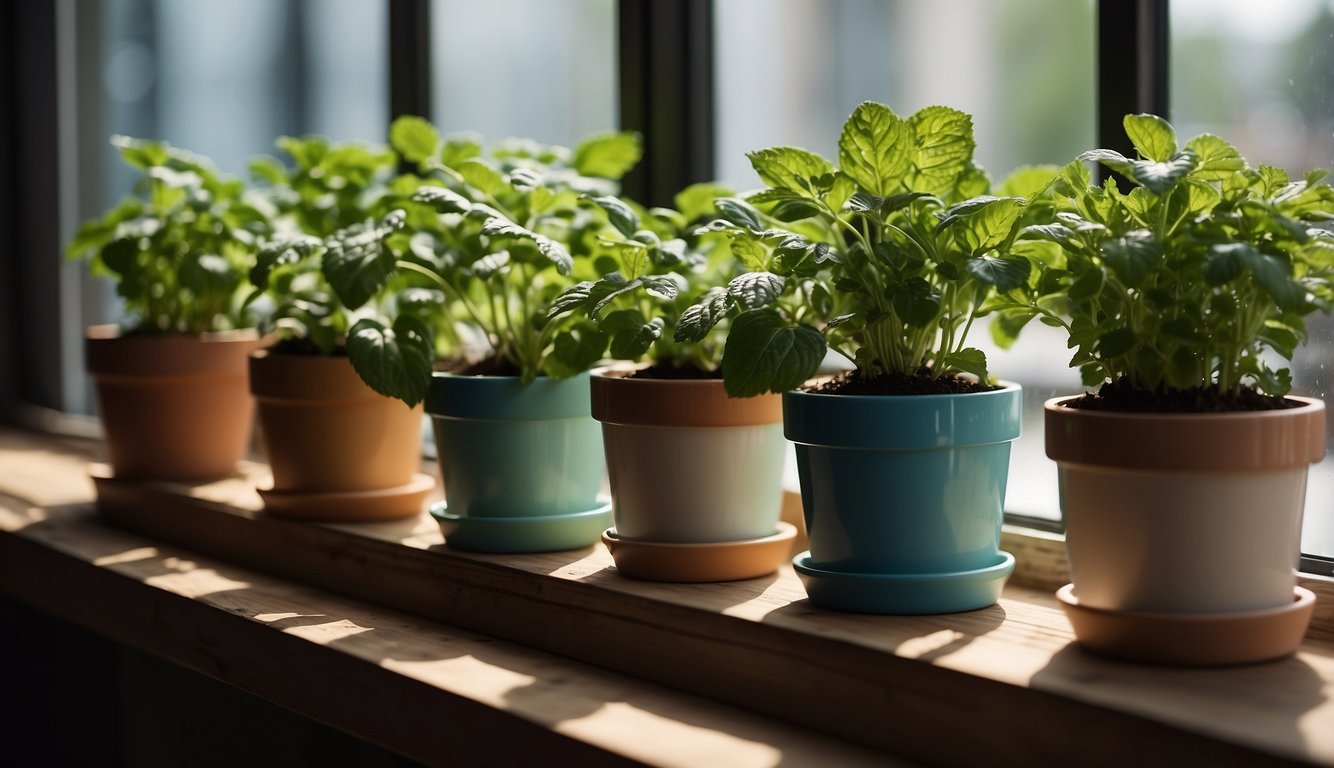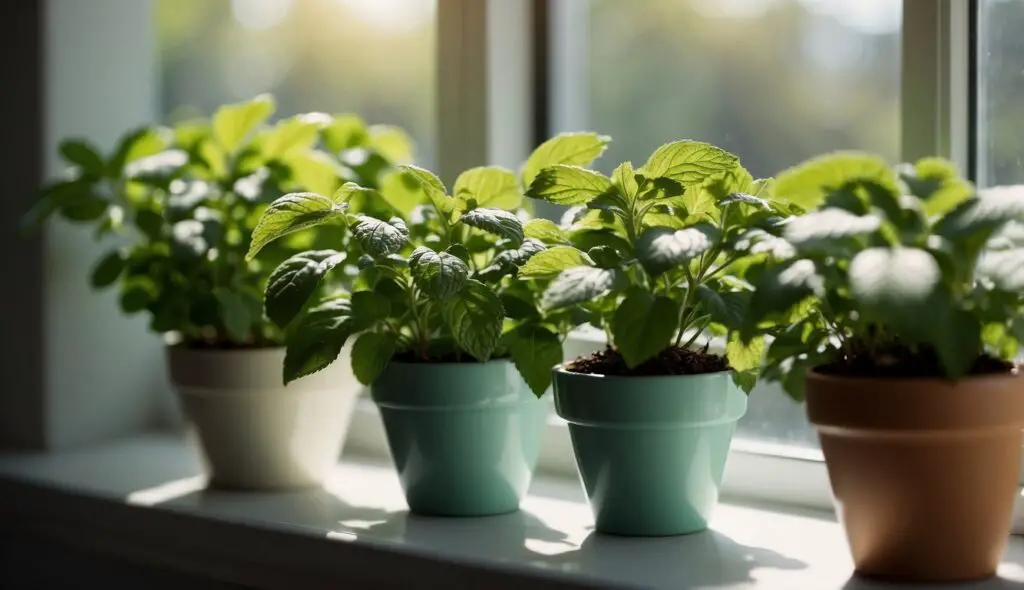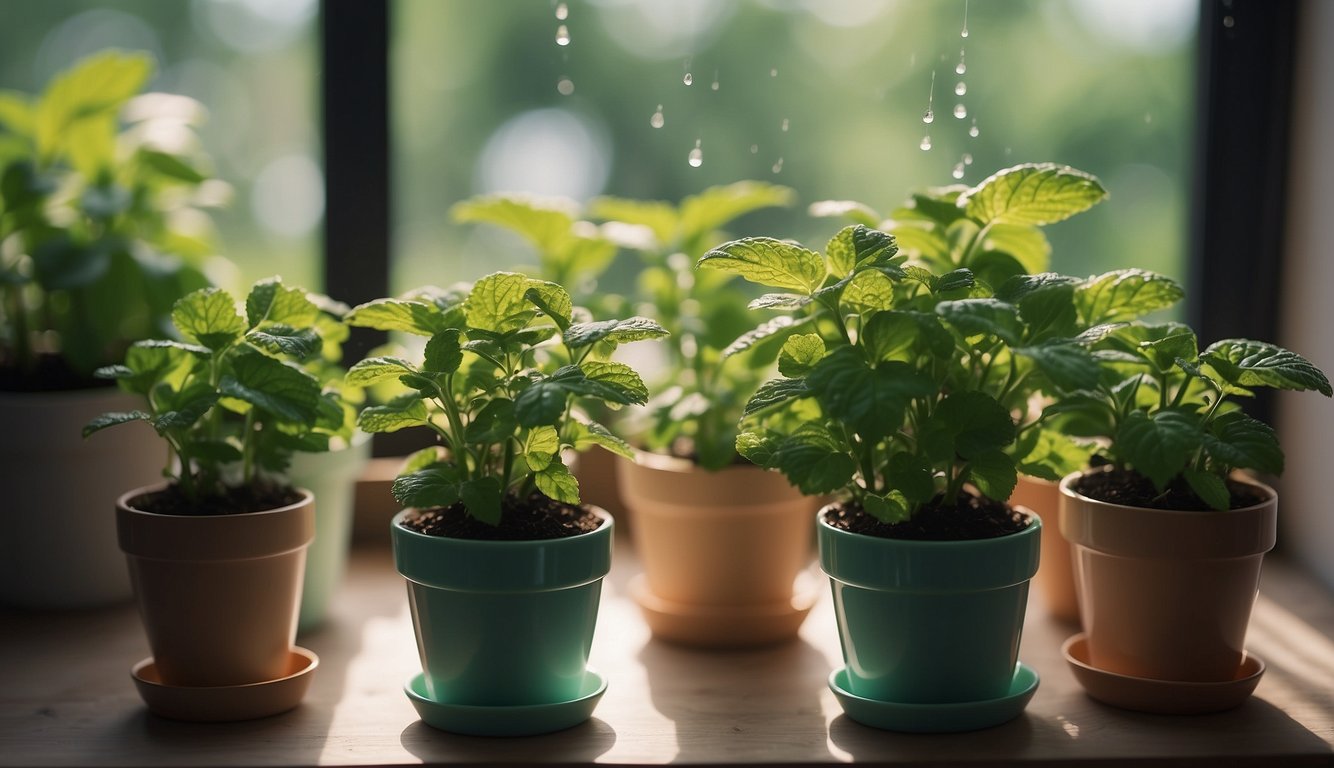How to Successfully Grow Mint Leaves Indoors? Growing mint leaves indoors lets you enjoy fresh herbs year-round. With the right conditions, you can easily grow a thriving mint plant at home. Mint is a versatile herb, perfect for cocktails, salads, and roasted vegetables.
To grow mint leaves indoors, you will need to provide the plant with plenty of light, water, and nutrients. Mint plants prefer bright light, so it is best to place them near a sunny window. If you don’t have a sunny window, you can also use grow lights to provide the plant with the light it needs. When it comes to watering, mint plants prefer moist soil, but they don’t like to sit in water. It’s important to let the soil dry out slightly between watering to prevent overwatering.
Benefits of Growing Mint Indoors
As an indoor gardener, I highly recommend growing mint indoors. Not only is it a great addition to your indoor garden, but it also has many benefits.
Aroma
One of the most obvious benefits of growing mint indoors is its aroma. The fresh scent of mint can help to freshen up your home and make it smell great. Plus, it can also help to mask unpleasant odors.
Fresh Mint – How to Successfully Grow Mint Leaves Indoors?
Another great benefit of growing mint indoors is that you will always have fresh mint on hand. You can use it in a variety of recipes, such as teas, cocktails, and desserts. Plus, you can also use it to freshen up your breath.
Perennial Herb
Mint is a perennial herb, which means that it will continue to grow year after year. This makes it a great investment for your indoor garden, as you will not need to replant it every year.
Easy to Grow – How to Successfully Grow Mint Leaves Indoors?
Mint is also very easy to grow, even for those who are new to indoor gardening. It is a low-maintenance plant that requires minimal care. Just make sure to keep the soil moist and provide it with plenty of sunlight.
Growing mint indoors is a great way to add some fresh greenery to your home while also reaping the benefits of its aroma, fresh mint, perennial nature, and ease of growth.
Sourcing Mint Plants for Indoor Cultivation
When it comes to growing mint indoors, the first step is to source your mint plant. There are a few options available, including cuttings, seeds, and starter plants.
Cuttings
If you have access to an established mint plant, you can take cuttings to propagate new plants. Cuttings should be taken from the tips of healthy stems and should be around 3-4 inches long. Remove the leaves from the bottom inch of the cutting and place them in a glass of water. Change the water every few days and wait for roots to form. Once the roots are around an inch long, you can transplant the cutting into the soil.
Seeds
Mint plants can be grown from seeds, but it’s important to note that they can be difficult to germinate. If you choose to grow mint from seeds, be sure to purchase high-quality seeds from a reputable source. Sow the seeds in a well-draining soil mix and keep them moist. Mint seeds typically take around 10-15 days to germinate.
Starter Plants – How to Successfully Grow Mint Leaves Indoors?
The easiest way to get started with indoor mint cultivation is to purchase a starter plant. Spearmint, peppermint, chocolate mint, apple mint, and orange mint are all popular varieties that can be found at most nurseries or garden centres. When selecting a starter plant, look for one that is healthy and has no signs of pests or disease.
No matter which method you choose, it’s important to remember that mint is a vigorous plant that can quickly take over a garden or container. Be sure to give your mint plant plenty of room to grow and consider growing it in a separate container to prevent it from spreading to other plants. With the right care and attention, you can enjoy fresh mint leaves all year round.
Essential Tips for Growing Mint Indoors
Mint is a great herb to grow indoors, as it can be used in a variety of recipes and for medicinal purposes. Here are some essential tips for growing mint indoors:
Select a Suitable Container
When growing mint indoors, it’s important to choose a container that is suitable for the plant’s needs. Mint requires good drainage, so be sure to choose a container with drainage holes at the bottom. A container that is too small can also hinder the plant’s growth, so choose a container that is at least 6 inches deep and 12 inches wide.
Use Fresh Potting Mix – How to Successfully Grow Mint Leaves Indoors?
Using fresh potting mix is important for the success of your mint plant. A good potting mix should be light and airy, with good drainage. You can make your potting mix by combining vermiculite, peat moss, and perlite, or you can purchase a pre-made potting mix from your local garden centre.
Maintain Consistent Watering
Mint requires moist soil, so it’s important to maintain consistent watering. Water your mint plant when the soil feels dry to the touch, but be careful not to overwater it. Overwatering can lead to root rot and other issues. You can also mist the plant with a spray bottle to provide additional moisture.
Provide Adequate Light
Mint requires adequate sunlight to grow, but too much direct sunlight can be harmful to the plant. Place your mint plant in a location that receives indirect sunlight or morning sun only. If you don’t have access to natural sunlight, you can use grow lights to provide the necessary light for your mint plant.
By following these essential tips, you can successfully grow mint indoors and enjoy its many benefits.
Three Methods to Grow Mint Indoors – How to Successfully Grow Mint Leaves Indoors?

Growing mint indoors is easy and can be done in three different ways: in soil, in water, or hydroponically. Each method has its advantages and disadvantages, and the choice depends on personal preference and the resources available.
Growing Mint in Soil
Growing mint in soil is the most common and traditional method. It requires a pot with moist soil, good drainage, and a sunny window. The pot should be at least 6 inches deep and wide enough to accommodate the roots. The soil should be moist but not waterlogged, and the pH should be between 6.0 and 7.0. Mint prefers rich, loamy soil that is well-drained.
To grow mint from seed, sow the seeds in the soil and cover them with a thin layer of soil. Water the soil gently and keep it moist until the seeds germinate, which takes about 10 to 14 days. Once the seedlings are established, thin them to one or two per pot. Mint can also be propagated by taking cuttings from an existing plant and planting them in soil.
Growing Mint in Water – How to Successfully Grow Mint Leaves Indoors?
Growing mint in water is a simple and low-maintenance method. It requires a jar or vase filled with water, and a sunny window. The mint cuttings should be about 4 inches long and have at least two nodes. Remove the lower leaves and place the cuttings in the water, making sure that the nodes are submerged. Change the water every few days to prevent stagnation and bacterial growth.
The cuttings will develop roots in a few weeks and can be transplanted into the soil or kept in the water. Mint grown in water may have weaker roots and less flavor than mint grown in soil, but it is a good option for beginners or those with limited space.
Growing Mint Hydroponically
Growing mint hydroponically is a modern and efficient method that uses a nutrient solution instead of soil. It requires a hydroponic system, which can be bought or made at home, and a sunny window or grow light. The system should have a reservoir for the nutrient solution, a pump for circulation, and a tray or net pots for the plants.
To grow mint hydroponically, plant the mint cuttings or seeds in the tray or net pots, and fill them with pebbles or another inert medium. The roots should be submerged in the nutrient solution, which should have the right balance of nutrients and pH. Mint grown hydroponically can grow faster and yield more than mint grown in soil or water, but it requires more maintenance and investment.
Growing mint indoors is a rewarding and easy activity that can provide fresh herbs all year round. Whether you choose to grow mint in soil, water, or hydroponically, make sure to provide the right conditions and care for the plants to thrive.
Caring for Indoor Mint Plants – How to Successfully Grow Mint Leaves Indoors?
Growing mint indoors is an excellent way to ensure a fresh supply of this versatile herb throughout the year. However, to keep your indoor mint plant healthy, you need to provide proper care. Here are some tips on how to care for your indoor mint plant:
Fertilizing – How to Successfully Grow Mint Leaves Indoors?
Indoor mint plants require regular fertilization to maintain their growth and flavor. You can use a balanced liquid fertilizer or fish emulsion once every two weeks during the growing season. Be careful not to over-fertilize, as this can damage the plant.
Pruning
Pruning is an essential part of caring for indoor mint plants. Regular trimming helps to keep the plant healthy and encourages new growth. You can prune your mint plant by cutting back the stems to just above a leaf node. This will encourage the plant to produce new runners and foliage.
Humidity and Air Circulation
Indoor mint plants thrive in high humidity and good air circulation. You can increase the humidity around your plant by placing a tray of water near it or using a humidifier. Make sure to provide good air circulation by opening windows or using a fan.
Pests and Damage – How to Successfully Grow Mint Leaves Indoors?
Indoor mint plants are susceptible to pests such as spider mites and mealybugs. Regularly inspect your plant for signs of damage or infestation. If you notice any pests, you can use an insecticidal soap to get rid of them.
Caring for indoor mint plants requires regular fertilization, pruning, and attention to humidity and air circulation. By following these tips, you can ensure that your indoor mint plant stays healthy and produces a steady supply of fresh mint leaves.
Harvesting Indoor Mint
Once your mint plant has grown to a sufficient size, it’s time to start harvesting! Harvesting your indoor mint is a simple process that can be done regularly to keep your plant healthy and promote growth.
To harvest your mint, simply snip off a few leaves or stems at a time, using sharp scissors or pruning shears. It’s best to harvest in the morning, as this is when the oils in the leaves are most concentrated.
When harvesting mint leaves, it’s important to avoid removing more than one-third of the plant at a time. This will help ensure that your plant continues to grow and thrive.
Fresh mint leaves can be used in a variety of recipes, including mojitos, herbal tea, and more. They can also be used to add fragrance to your home, simply by placing a few leaves in a small bowl or jar.
Overall, harvesting indoor mint is a simple and rewarding process that can be done regularly to keep your plant healthy and promote growth. Whether you’re using your fresh mint leaves in recipes or simply enjoying their fragrance, your indoor mint plant is sure to bring joy and beauty to your home.
Before You Go – How to Successfully Grow Mint Leaves Indoors?

Growing mint indoors is an easy and rewarding experience. By following the tips and tricks outlined in this article, you can successfully cultivate a perennial herb that will provide you with fresh sprigs of mint throughout the growing season.
One of the key advantages of indoor growing is that you can enjoy mints all year round, regardless of the weather outside. Mint is a prolific plant that responds well to indoor growing conditions, so you can expect to have a steady supply of fresh leaves for use in cooking, teas, and cocktails.
To get started, you will need to acquire a mint seedling or take tip cuttings from an existing plant. Once you have planted your mint in a well-draining pot with good-quality soil, you can begin to enjoy the many benefits of indoor growing.
Remember to keep your mint plant in a well-lit spot, as it requires plenty of sunlight to thrive. You may also need to supplement with a grow lamp if natural light is limited in your indoor space.
To ensure your mint plant remains healthy and productive, it is important to keep it well-watered and to fertilize it regularly. With a little care and attention, you can enjoy the many benefits of growing mint indoors for years to come.
How to Successfully Grow Mint Leaves Indoors: A Herbalist’s Guide
Hello, plant enthusiasts! Today, we’re diving into the refreshing world of mint. Specifically, we’re going to talk about how to successfully grow mint leaves indoors. Yes, you can grow this aromatic herb right in your home!
First off, let’s talk about why you’d want to grow mint indoors. It’s simple – it’s a fantastic way to have fresh mint on hand for your culinary creations! Plus, it’s a great way to bring a touch of greenery indoors.
Now, let’s tie this back to theherbprof.com. As your friendly neighbourhood Herbalist Blogger, I’m all about helping you nurture your green thumb. And growing mint indoors? It’s a perfect example!
By growing your mint, you’re not just adding flavor to your dishes. You’re also embracing the principles of indoor gardening, a topic I’m passionate about and often discuss on my blog, theherbprof.com.
References – How to Successfully Grow Mint Leaves Indoors?
Little Herb Encyclopedia, by Jack Ritchason; N.D., Woodland Publishing Incorporated, 1995
The Ultimate Healing System, Course Manual, Copyright 1985, Don Lepore
Planetary Herbology, Michael Tierra, C.A., N.D., Lotus Press, 1988
Handbook of Medicinal Herbs, by James A. Duke, Pub. CRP Second Edition 2007
The Complete Medicinal Herbal, by Penelope Ody, Published by Dorling Kindersley
Check the Following Articles!
Coffee Grounds Pest Control: How to Keep It Away Naturally
Pros and Cons of Salvia: A Comprehensive Overview
Grow Carrots in Bag: An Efficient Guide for Beginners
Do Rabbits Eat Rhubarb? The Truth About Consumption
Frequently Asked Questions – How to Successfully Grow Mint Leaves Indoors?
1. What are the necessary steps to propagate mint from cuttings indoors?
To propagate mint from cuttings, first, take a 4-inch sprig from an existing mint plant and remove the bottom leaves. Dip the cut ends in rooting hormone and gently shake off the excess. Insert the stems into prepared four- or six-inch pots filled with a humus-rich potting mix. Water gently and keep the soil moist but not wet. Place the pots in a warm and bright location, but avoid direct sunlight. In about two weeks, the cuttings should develop roots, and new growth should appear.
2. How often should indoor mint plants be watered for optimal growth?
Mint plants should be watered regularly, but not over-watered. Over-watering can lead to root rot, which can kill the plant. The frequency of watering depends on the temperature, humidity, and soil type. Generally, mint plants should be watered when the top inch of soil feels dry to the touch. It is better to water deeply but less frequently than to water lightly and frequently.
3. Is artificial light sufficient for growing mint indoors, and if so, what type is recommended?
Yes, artificial light can be used to grow mint indoors. A full-spectrum LED grow light is recommended because it provides the right light spectrum for plant growth and is energy-efficient. The light should be placed about 6 to 12 inches above the plants and should be on for 12 to 16 hours a day.
4. What are the advantages of cultivating mint within a home environment?
Cultivating mint within a home environment has several advantages. Mint is a versatile herb that can be used in many recipes, from teas to cocktails to desserts. Growing mint indoors ensures a fresh and steady supply of this herb. Mint also has many health benefits, such as aiding digestion and reducing stress. Growing mint indoors is an easy and rewarding way to add greenery to your home.
5. Can mint be successfully grown indoors during colder seasons, and what special care is required?
Yes, mint can be grown indoors during colder seasons, but it requires special care. Mint prefers temperatures between 60 and 70 degrees Fahrenheit and high humidity. During the winter months, the air in our homes can be dry, so it is important to mist the plants regularly or use a humidifier. Mint also needs good air circulation and should not be placed in a drafty location.
6. What is the proper method for growing mint in water indoors?
Growing mint in water is easy and requires minimal effort. Take a stem cutting from an existing mint plant and place it in a glass of water. Change the water every few days and keep the glass in a bright location, but avoid direct sunlight. In about two weeks, the cutting should develop roots, and new growth should appear. Once the roots are established, transfer the cutting to a pot with soil and continue to care for it as you would any other mint plant.

